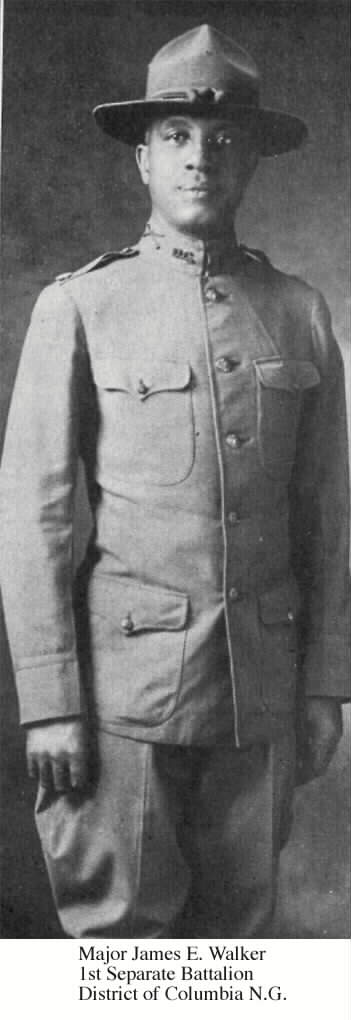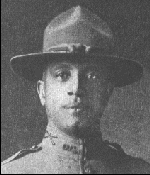Major James E. Walker, the colored officer who was in command of the First Separate Battalion, District of Columbia Infantry National Guard, when it was called to guard the National Capital, was born in Albemarle County, Virginia, September 7, 1874.
He attended the public schools and was graduated from the high and normal schools of the District of Columbia. He was connected with the public schools of the District for more than twenty-four years as a teacher and supervisor of the Thirteenth Division and served as such until ordered to the Mexican border with the District of Columbia National Guard in 1916.
His military services began in 1896, when he was appointed first lieutenant in the First Separate Battalion of the National Guard of the District of Columbia. In 1909 he was commissioned captain; in 1912, by and through a competitive examination, he was commissioned Major, after the resignation of Major, now Lieutenant-Colonel, Arthur Brooks.
The First Separate Battalion, under Major Walker, was the first unit of the District National Guard to be recruited to war strength in Washington City, and they were among the first troops to be sent to the Mexican border at the time war threatened between Mexico and the United States in 1916. They immediately relieved the troops of the regular army and were assigned to the duty of guarding the water works at Naco, Arizona, which supplied five or six towns in the vicinity. Aside from his duties there as battalion commander, Major Walker was selected to act as intelligence officer for the Government.
On March 25, 1917, the battalion was called on to guard the National Capital, and it was there that the constant vigil of Major Walker began its inroads on his health. He realized that in selecting his command to safely guard the National Capital, with its public buildings, water supply, railroads and all other important facilities, the Government was prompted in its selection by the high rate of efficiency and undoubted loyalty which his battalion had established for itself, and in order to continue in this high regard, he sacrificed health and everything else save that which makes for the true soldier—duty.
He was ordered to Fort Bayard, New Mexico, to the United States hospital, for treatment, hoping to regain his health. However the best medical skill was of no avail and he died, April 4, 1918, the first officer of the military forces of the District of Columbia to give his life for the Nation and world-democracy. His remains were sent home with military escort, and his body was interred in Arlington National Cemetery.
His funeral, which was conducted from the Nineteenth Street Baptist Church, Washington, D. C., of which Rev. W. H. Brooks is pastor, was attended by a large proportion of the colored citizenship of the District of Columbia, who, despite the cold, bleak day, followed his remains to Arlington Cemetery.
In the 500 block of T Street, NW is the former home of Major James E. Walker, Commander of the First Separate Battalion, D.C. National Guard, the local all-black unit in World War I. Walker, a District school teacher and later supervising principal who once served at Syphax and Banneker schools, joined the battalion in 1896. By 1912, he had been commissioned a Major. Four years later, the First Separate Battalion was sent to the Arizona-Mexico border where it saw service against the Mexican revolutionary Pancho Villa.
In 1917, one of the First Separate Battalion, D.C National Guard, became the first American Army units called into service. The battalion’s initial mission was to defend the nation’s capital. On January 1, 1918, the First Separate Battalion was ordered to Camp Stuart at Newport News, VA. Once there, the unit became companies A through D of the 372nd Infantry Regiment, 93rd Infantry Division. While sailing to France, Major Walker’s men learned that he had died of tuberculosis. Major James E. Walker is buried at Arlington National Cemetery. At least one local American Legion Post and a District elementary school are named in his honor.
In combat in France, the Regiment comprising Walker’s men, the 372nd lost 33 men killed and more than a third of its men were wounded in battle. Several soldiers as well as the unit itself were cited by the French Army for bravery. One witness, a young white lieutenant, said that casualties were heavy in Walker’s former unit because the men refused to surrender or retreat.
Major Walker’s brother-in-law Athur C. Newman who lived next door the corner later commanded the First Separate Battalion. A number of other black men from D.C. served as officers in the First World War. The Curtis family sent three of its sons: A. Monroe, Arthur, and Merrill. They were all First Lieutenants, two in the Medical Corps and one in the Field Artillery.
Indeed, the service of all the District’s black men in World War I, although seldom discussed, is a record in which all Americans can take pride.
WALKER, JAMES E
- MAJOR 372ND INF 1ST SEP BN D C INF
- VETERAN SERVICE DATES: Unknown
- DATE OF DEATH: 04/04/1918
- DATE OF INTERMENT: Unknown
- BURIED AT: SECTION 2 SITE 3575
- ARLINGTON NATIONAL CEMETERY
WALKER, BEATRICE J W/O JAMES E
- DATE OF DEATH: 08/25/1949
- BURIED AT: SECTION 2 SITE 3575
- ARLINGTON NATIONAL CEMETERY
Michael Robert Patterson was born in Arlington and is the son of a former officer of the US Army. So it was no wonder that sooner or later his interests drew him to American history and especially to American military history. Many of his articles can be found on renowned portals like the New York Times, Washingtonpost or Wikipedia.
Reviewed by: Michael Howard


